Cline vs Cursor: Choosing the Best AI Coding Assistant for Developers
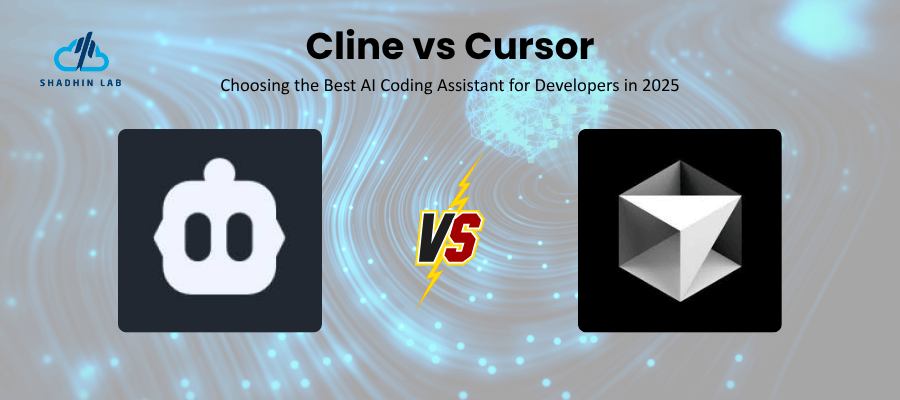
Table of Contents
Have you ever imagined what it would be like if coding could feel faster, smarter, and more intuitive? AI-powered development tools are turning that idea into reality. In 2025, coding assistants and intelligent editors are transforming the way developers write, debug, and manage projects. These tools are no longer just simple autocomplete features. They understand context, suggest improvements, automate repetitive tasks, and even help maintain coding standards across complex projects.
Among the leading AI development tools are Cline and Cursor, each offering powerful solutions tailored to different development needs. Cline shines when it comes to automating routine coding tasks, helping individual developers and small teams save time and maintain consistency. Cursor, on the other hand, excels at managing large codebases, multi-language projects, and collaborative workflows, providing deep context awareness and AI-driven insights across entire repositories.
With the growing complexity of software projects, developers are constantly seeking ways to reduce manual effort, avoid repetitive errors, and optimize their workflow. AI coding assistants like Cline and Cursor are not just tools—they are partners that adapt to your coding style, guide you through complex logic, and support both solo and team projects.
Table of Contents
Key Takeaways
- In this article, you will understand how AI coding tools like Cline and Cursor improve developer productivity, streamline workflows, and reduce errors.
- Discover how Cline automates repetitive coding tasks, allowing individual developers and small teams to focus on logic and innovation.
- Explore how Cursor manages large codebases, multi-language projects, and collaborative environments with advanced context awareness.
- Learn to evaluate your workflow, project complexity, and team size to choose the tool that fits your development needs best.
- See the similarities between Cline and Cursor in improving coding efficiency while understanding their unique strengths.
- Test both platforms firsthand to determine which AI assistant aligns most effectively with your style, goals, and project requirements.
What is Cline?
Cline is an AI-powered coding companion designed to help developers write, edit, and refactor code faster. It understands context from your existing codebase and provides intelligent suggestions to automate repetitive development tasks.
Unlike traditional code assistants, Cline focuses on context-driven automation. It doesn’t just autocomplete your lines — it analyzes your project’s structure, logic, and dependencies to generate solutions that feel tailor-made. Whether you’re working on debugging or adding a new feature, Cline helps minimize manual effort while maintaining code quality.
Cline positions itself as a developer-focused tool that blends the power of AI with everyday coding workflows — perfect for small teams, solo developers, and agile projects looking for lightweight yet powerful assistance.
Key Features of Cline
Cline packs several smart features that make coding more intuitive and efficient:
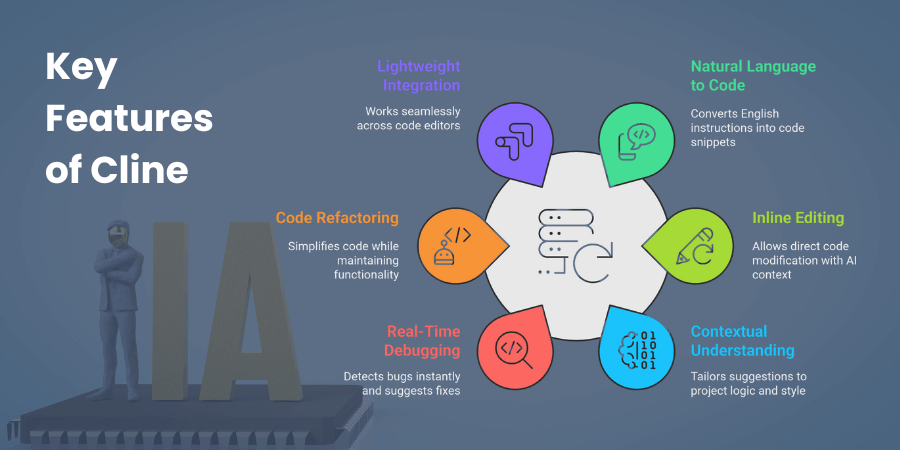
- Natural Language to Code: Write instructions in plain English, and Cline converts them into working code snippets.
- Inline Editing: Modify or refactor existing code directly within your editor using AI-driven context.
- Contextual Understanding: Cline reads the structure of your project and tailors its suggestions to match the specific logic and style of your code.
- Real-Time Debugging: Detects bugs instantly and offers AI-generated fix suggestions to streamline debugging.
- Code Refactoring: Simplifies complex code with cleaner, optimized alternatives while maintaining functionality.
- Lightweight Integration: Works seamlessly across multiple code editors with minimal setup.
What is Cursor?
Cursor is another powerful AI-driven code editor that’s quickly becoming a favorite among modern developers. It’s built to extend traditional IDEs with next-level AI assistance — blending automation with real-time collaboration and learning.
Cursor acts more like an AI-integrated IDE than a simple code assistant. It offers intelligent autocompletion, instant code search, and debugging tools that understand the broader context of your project. Its goal? To let developers write better code faster, while maintaining complete control over their workflow.
Cursor integrates seamlessly with tools like VS Code, GitHub, and popular frameworks, making it a natural choice for developers working on enterprise-grade or multi-language projects.
Key Features of Cursor
Here’s what sets Cursor apart as a full-fledged AI code editor:
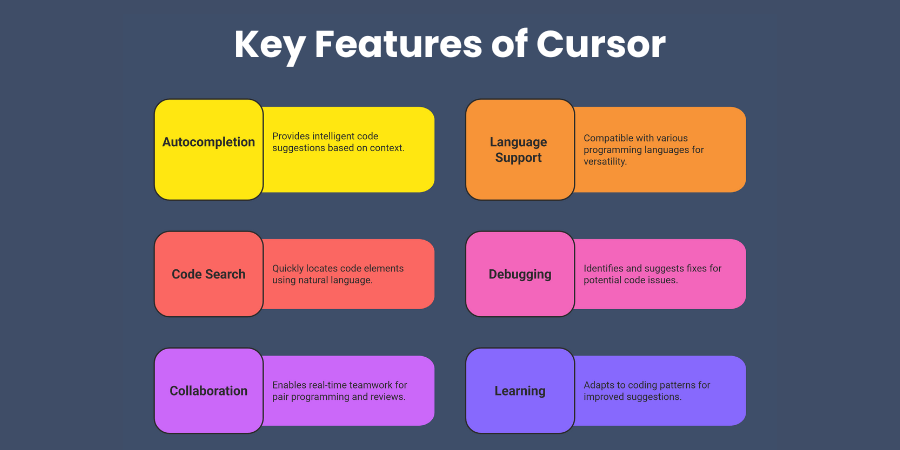
- AI-Based Autocompletion: Offers smart, context-sensitive suggestions across multiple programming languages.
- Multi-Language Support: Works efficiently with JavaScript, Python, Java, TypeScript, C++, and more.
- Project-Wide Code Search: Find functions, classes, and dependencies instantly using natural language queries.
- Intelligent Debugging: Identifies potential issues, explains the cause, and suggests automated fixes.
- Collaboration Tools: Allows real-time teamwork, making pair programming and review sessions easier.
- Learning Capability: Adapts to your coding patterns over time for increasingly accurate suggestions.
Cline vs Cursor: Head-to-Head Comparison Table
Here’s a quick look at how Cline and Cursor compare across the most important categories developers care about:
| Category | Cline | Cursor |
| Ease of Use | Simple and lightweight; ideal for smaller teams or solo devs | Full-featured IDE experience; suited for advanced users |
| AI Accuracy | High for context-aware code generation | Excellent for predictive code suggestions and multi-language tasks |
| Supported Languages | Popular languages like Python, JavaScript, and TypeScript | Broad range including Java, Python, Go, and more |
| Debugging Tools | Real-time AI-assisted debugging | Deep, interactive debugging with explanations |
| Collaboration | Limited collaboration tools | Built-in team collaboration features |
| Integrations | Works smoothly with lightweight editors | Integrates with VS Code, GitHub, and enterprise tools |
| Customization | Moderate customization options | Highly customizable for large projects |
| Pricing | Generally more affordable | Premium pricing for advanced features |
| Best For | Freelancers, startups, small dev teams | Enterprise teams, large-scale development, and AI-driven coding |
Key Differences Between Cline and Cursor
While Cline and Cursor both aim to make development faster and smarter, the way they do it feels completely different. Their design, features, and target users set them apart in meaningful ways. If you have ever wondered which one fits your workflow better, this section will help you figure that out. Each platform serves a unique purpose and suits a specific type of developer. Some prefer Cline’s simplicity and speed, while others lean toward Cursor’s depth and collaboration strength. Before deciding which tool to use, it is important to understand how they differ in structure, scalability, and overall experience. Let us take a closer look at what makes each of them stand out and why those differences matter for your coding journey.
| Category | Cline | Cursor |
| Primary Focus | Context-driven AI automation and lightweight coding assistance | Full-scale AI-powered development environment with collaboration features |
| User Type | Individual developers, freelancers, small startups | Teams, enterprises, and large-scale development organizations |
| Interface Design | Minimalist, distraction-free, and performance-focused | Feature-rich IDE-like environment with advanced controls |
| AI Functionality | Reads and understands project context for smart suggestions | Provides real-time AI assistance with predictive, large-scale code management |
| Supported Languages | Popular ones like Python, JavaScript, TypeScript | Broad range including Python, Java, Go, C++, and more |
| Integration Capabilities | Works with lightweight editors and local setups | Integrates with VS Code, GitHub, and enterprise CI/CD pipelines |
| Debugging Tools | Real-time AI debugging and quick refactoring support | Deep debugging, error explanation, and automated fix recommendations |
| Collaboration Support | Limited to individual use or small teams | Advanced multi-user collaboration, version control, and shared AI models |
| Performance | Fast, lightweight, ideal for smaller projects | Heavier but scalable for enterprise-grade applications |
| Customization | Moderate — focused on code automation and efficiency | High — customizable AI models, integrations, and workflows |
| Scalability | Designed for personal or small-scale projects | Built for large teams and enterprise systems |
| Pricing | Generally more affordable and flexible | Premium pricing for advanced enterprise-level features |
| Best For | Developers who want speed, simplicity, and efficient AI help | Teams needing collaboration, scalability, and end-to-end AI coding environment |
Similarities Between Cline and Cursor
Although Cline and Cursor differ in structure and focus, they share several similarities that make them stand out among today’s AI coding tools. Both platforms are designed with one clear goal — to help developers write better code, faster, and with less effort.
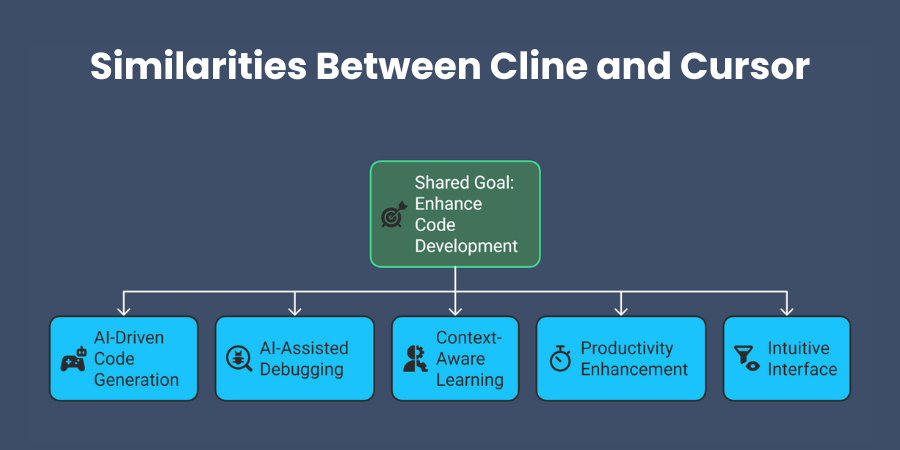
Both Cline and Cursor use AI-driven code generation as their foundation. They transform natural language prompts into functional code snippets, allowing developers to express their ideas conversationally. This feature bridges the gap between coding expertise and creativity, making both platforms highly accessible to developers at different experience levels. Another major similarity lies in their AI-assisted debugging. Instead of manually tracing bugs or syntax errors, developers can rely on each tool’s smart debugging engine to detect issues, explain errors, and even suggest or apply fixes automatically. This not only reduces development time but also improves code quality by eliminating common oversights.
Both tools are also context-aware, meaning they learn from your existing codebase and adapt to your individual coding style. Over time, they provide more accurate suggestions that fit your workflow and language preferences. This personalized AI learning makes development smoother and more efficient the longer you use the tool. Productivity enhancement is a shared strength as well. Both Cline and Cursor aim to automate repetitive tasks like refactoring, documentation, or generating boilerplate code. By reducing manual effort, they allow developers to focus on logic, design, and solving real-world problems rather than routine tasks.
Finally, both tools offer intuitive, developer-friendly interfaces that make navigation and editing effortless. Whether you prefer Cline’s minimalist environment or Cursor’s full-featured IDE-like setup, both platforms ensure a seamless experience while switching between AI suggestions and manual control.
Best Use Cases for Cline
Wondering where Cline truly shines? If you’ve been looking for a smarter way to handle repetitive development tasks or boost your team’s productivity, this section is for you. Let’s explore how developers and teams are using Cline to make their workflow faster, cleaner, and far more efficient.
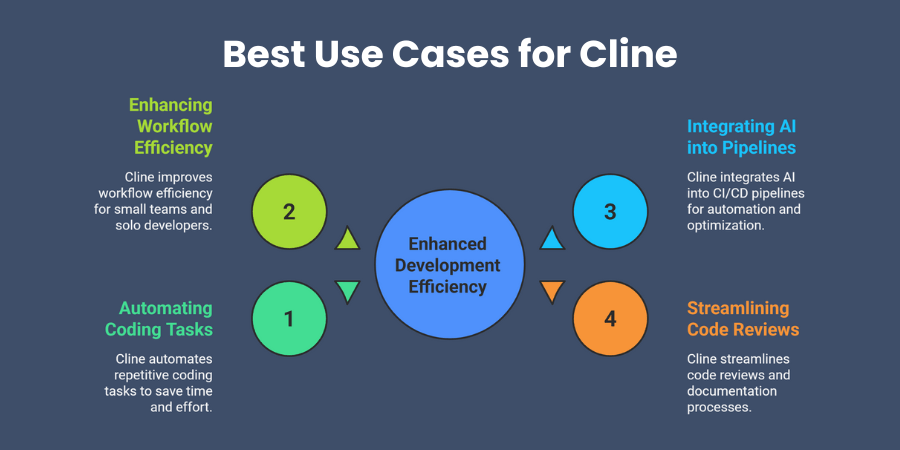
1. Automating Repetitive Coding Tasks
We all know how draining it can be to rewrite boilerplate code or perform the same setup steps repeatedly. Cline changes that. By learning your coding habits, it can automatically generate recurring structures, functions, and snippets across your projects.
Imagine working on multiple microservices — Cline can automatically handle file structuring, function templates, and API endpoint patterns, leaving you free to focus on logic and innovation.
Example: A backend team at a startup uses Cline to automate Spring Boot configurations and REST API template generation, cutting development time by 40%.
2. Enhancing Workflow Efficiency for Small Teams
If you’re part of a small dev team or a solo developer managing multiple projects, efficiency matters more than ever. Cline helps by becoming an intelligent partner that understands project context. It can track code dependencies, refactor across files, and even explain complex logic.
Cline doesn’t just save time — it creates smoother communication between developers by maintaining clean, consistent code.
Example: A two-person SaaS team uses Cline to review and refactor their frontend code, ensuring consistent React standards across multiple dashboards.
3. Integrating AI into Software Pipelines
Cline isn’t just a coding assistant — it’s a tool that integrates seamlessly into your CI/CD pipeline, bringing AI-driven automation to your software delivery process. From automated testing to deployment monitoring, it can intelligently suggest optimizations at every stage.
This is especially useful for DevOps teams looking to blend AI with traditional build, test, and deploy pipelines.
Example: A mid-size development agency integrated Cline into their Jenkins pipeline. The result? Faster test cycles, automated documentation updates, and fewer manual code reviews.
4. Streamlining Code Reviews and Documentation
Tired of repetitive review comments and writing detailed documentation after every update? Cline can automatically analyze pull requests, highlight inconsistencies, and even draft technical documentation based on your codebase.
It helps teams maintain standards effortlessly, especially when scaling.
Example: A fintech company uses Cline to summarize every pull request and generate version-based changelogs, saving developers hours of manual documentation work weekly.
5. Supporting Continuous Learning and Code Understanding
Cline acts as a real-time mentor for developers who want to grow their coding expertise. It explains logic, syntax, or framework behavior directly in context — no need to leave your IDE to Google it.
Example: Junior developers use Cline to understand advanced Java concepts in legacy codebases, improving onboarding speed and confidence during live projects.
Best Use Cases for Cursor
If you have ever handled a massive codebase, switched between different programming languages, or collaborated with teams across departments, then Cursor might be exactly what you need. It is more than just an AI-powered coding tool; it is a smart development partner designed for scale, precision, and teamwork. Let’s explore where Cursor truly delivers its best performance.
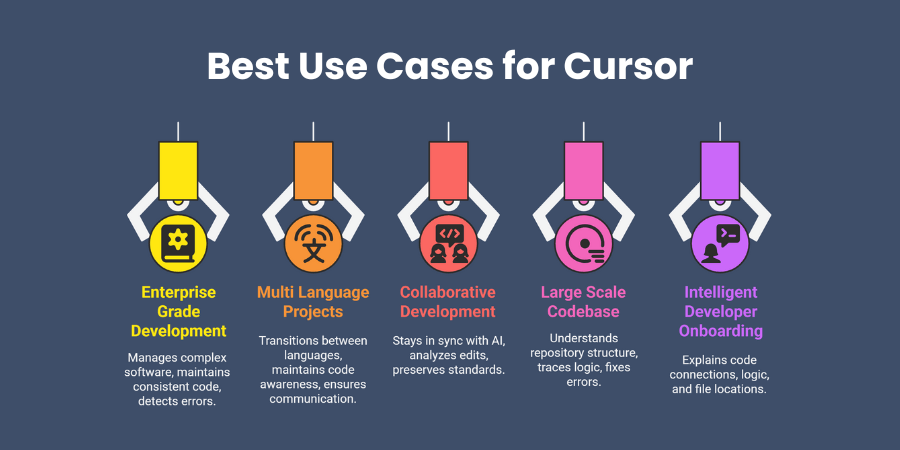
1. Enterprise Grade Development
Large organizations often manage complex software structures and interconnected systems. Cursor makes this easier by understanding your entire project context, not just one file at a time.
It helps enterprise teams maintain clean and consistent code, automate repetitive tasks, and instantly detect cross-project errors.
Example: A global software firm uses Cursor to manage large Java and TypeScript applications. The tool automatically tracks dependencies and identifies bugs across multiple repositories, reducing debugging time by nearly half.
2. Multi Language Project Environments
Handling several languages in one project can be tricky. Cursor is built for this kind of flexibility. It smoothly transitions between JavaScript, Python, Java, and other languages while maintaining full code awareness and context.
This makes it easier for teams to build complex systems where backend and frontend must work perfectly together.
Example: An AI startup combines Python-based machine learning models with a React frontend. Cursor ensures smooth communication between both ends, detecting data mismatches before deployment.
3. Collaborative Development Across Teams
When developers work together from different locations, version conflicts and communication gaps can slow everything down. Cursor helps teams stay in sync with AI-assisted collaboration tools that analyze edits, suggest fixes, and preserve coding standards.
It also summarizes changes made by others, so you understand updates without scrolling through endless commit logs.
Example: A remote development team working across five countries uses Cursor to maintain consistency in shared repositories. New contributors can understand team code faster through automatic AI summaries.
4. Large Scale Codebase Management
For projects with thousands of lines of code, navigating or refactoring can be exhausting. Cursor helps by deeply understanding your repository’s structure, allowing developers to jump across files, trace logic, and fix errors efficiently.
Example: A healthcare technology company managing multiple patient record integrations uses Cursor to refactor outdated modules, remove unused dependencies, and auto-generate documentation for better project visibility.
5. Intelligent Developer Onboarding
New developers often need time to understand existing projects. Cursor makes onboarding faster by explaining how different parts of the code connect, why certain logic exists, and where important files are located.
It feels like having a senior developer guiding you through every step.
Example: A new engineer at a SaaS company learned a three-year-old codebase within a week using Cursor’s in-depth explanations and code mapping features.
Which is Right for You
Choosing between Cline and Cursor depends on your workflow, project size, and team structure. If you are an individual developer working on small projects, Cline is an excellent option. It is lightweight, easy to set up, and automates repetitive coding tasks, allowing you to focus on the logic that matters most.
Its ability to quickly adapt to your coding style can significantly speed up daily development and reduce repetitive effort. Cursor can also support solo developers, especially those working with multiple programming languages or navigating complex codebases, but its strengths become more apparent in larger projects or collaborative environments.
For small teams, Cline helps maintain consistent coding practices, streamline workflows, and reduce the time spent on repetitive tasks. Cursor takes this further by providing AI-assisted context awareness across multiple files and languages, making collaboration smoother and helping teams stay aligned even in distributed setups. When it comes to large teams or enterprise level projects, Cursor generally provides the most benefit. Its deep understanding of massive codebases, multi-language projects, and complex pipelines allows developers to manage large scale collaboration effectively without losing context. Cline can still play a role in enterprise settings, particularly for individual developers within the team who want to automate personal coding tasks or maintain smaller modules efficiently.
Other factors to consider include project complexity, budget, and coding preferences. If your main goal is speeding up individual work and automating repetitive tasks, Cline is likely the right choice. If your focus is managing complex projects, collaborating across teams, or handling multiple languages in one codebase, Cursor is better suited to meet those needs. Understanding your priorities and workflow will help you choose the tool that fits best.
Conclusion
Cline and Cursor are both powerful AI coding tools designed to make development faster, smarter, and more efficient, yet they serve slightly different purposes. Cline excels at automating repetitive coding tasks and boosting productivity for individual developers and small teams, while Cursor shines in managing large codebases, multi-language projects, and collaborative environments with advanced AI context awareness. Despite these differences, both tools aim to streamline workflows, reduce errors, and enhance coding efficiency. The best way to determine which platform fits your needs is to explore both and experience how each aligns with your workflow, project complexity, and development goals. Testing them firsthand will help you choose the AI coding assistant that truly complements your style and maximizes your productivity.
Frequently Asked Questions
What is the difference between Cline and Cursor?
Cline focuses on automating repetitive coding tasks and boosting productivity for individual developers and small teams, while Cursor excels in managing large codebases, multi-language projects, and collaborative environments.
Can I use both Cline and Cursor together?
Yes, many developers use both tools depending on the task. Cline can speed up routine coding, while Cursor helps with large projects or team collaboration.
Which tool is better for solo developers?
Cline is often better for solo developers due to its lightweight setup and automation features. Cursor is useful if you work on complex projects or multiple languages.
Is Cursor suitable for enterprise projects?
Absolutely. Cursor is designed for large-scale codebases and team collaboration, making it ideal for enterprise development environments.
How can I decide which tool fits my workflow best?
The best way is to test both platforms with your projects. Consider project size, complexity, coding preferences, and whether you work individually or in a team.
Shaif Azad
Related Post
Top 10 AI Development Companies in New Jersey for Business
Are you searching for the perfect AI development partner in New Jersey? Have you wondered which...
Top 10 AI Development Companies in New Hampshire
Are you watching New Hampshire’s tech landscape transform before your eyes? Your state is quietly becoming...
Top AI Companies in Nebraska Every Business Should Know
Are you a Nebraska business owner wondering how artificial intelligence could transform your operations? Picture this...




